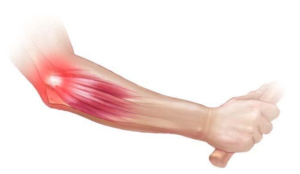
Tennis Elbow
Have you recently picked up a racket sport such as tennis, badminton, squash, or even golf? Maybe now your dominant elbow and forearm are hurting. If this describes you, there is a good chance you overworked your forearm muscles with repeated gripping (1) and swinging arm movements, causing an overuse injury of the common extensor tendon. This condition is commonly known as Tennis Elbow or lateral epicondylitis (1,2).
(Picture from Mayo Clinic)
What is tennis elbow?
The elbow is a structure involving connecting bones, ligaments, connective tissues, the elbow joint, several muscle attachments, and fluid-filled sacs designed to absorb forces. Repetitive or excessive movement causes injury and damage to these structures, and your elbow becomes less able to work properly!
Lateral epicondylitis is a degenerative overuse injury (3) to a specific forearm muscle and tendon: the extensor carpi radialis muscle and the common extensor tendon. Research studies investigating lateral epicondylitis patients with diagnostic ultrasound found numerous conditions, including calcifications (calcium deposits), microtears, and thickening of the common extensor tendon and extensor carpi radialis muscle. The findings are common with degenerative overuse injuries involving tendons, although lateral epicondylitis can also occur after trauma.
Lateral epicondylitis most commonly presents with a slow, sore onset of elbow pain, specifically located on the outer knob of the elbow. The pain improves with rest and worsens with activity. A loss of grip strength or motor control may be noticed first, too. (3) The pain most commonly starts 1 to 3 days after picking up an unaccustomed sport or activity that involves repetitive gripping and forearm extension.
Lateral epicondylitis can also be precipitated with an acute injury or strain of the extensor muscles, such as lifting a heavy object or performing a very hard backhand in tennis. Such an acute injury can lead to a more chronic lateral epicondylitis if left untreated or returning to sport or work too early. (1,2)
Read more about elbow anatomy and tennis elbow here: https://www.mayoclinic.org/diseases-conditions/tennis-elbow/symptoms-causes/syc-20351987
Who gets tennis elbow?
Although tennis elbow is named after a sport, only about 10% of all patients present with lateral epicondylitis are tennis players. Lateral epicondylitis can affect anyone with repetitive movements, including gripping and swinging the arms, not just athletes. Carpenters, plumbers, electricians, gardeners, rock climbers, and any new activity involving prolonged gripping and lifting can aggravate the elbow and tendons. (4) Even using handheld tools or playing with your dog by throwing frisbees can strain the forearm muscles and cause lateral epicondylitis.
Mechanics, dentists, surgeons, furniture movers, and assembly line workers who tend to have repeated gripping and twisting motion using a handheld tool at work can also be predisposed to presenting with lateral epicondylitis. (4)
Poor ergonomics at work, such as desk-chair set-ups, can predispose a person to develop this elbow condition. At MN Spine and Sport, our Woodbury chiropractors can offer professional guidance on how to optimize your work set-up to avoid injury over time.
How do I know if I have tennis elbow?
Symptoms of lateral epicondylitis include sharp, burning, or aching pain and discomfort on the bony knob outside your elbow. (1,2,3) The pain may extend or radiate into the upper or lower arm. You may notice discomfort when lifting objects, shaking hands, opening a door, raising your hand, or making a fist to grip an object, such as a spoon or tennis racket.
How is tennis elbow assessed?
Diagnosing tennis elbow requires a complete and thorough patient history. Imaging, such as x-rays, may not be needed unless the pain is severe and/or acute trauma has occurred, such as a slip-and-fall or motor vehicle accident. (3,4)
A standard exam from our Woodbury chiropractors may include palpation of the forearm along the elbow and maneuvering your arm and wrist into specific positions to better understand what tissues are involved. From here, our Woodbury chiropractors will create a specific conservative treatment plan tailored to you and your symptoms.
Research has shown that 80-90% of tennis elbow cases will resolve spontaneously within 1 or 2 years. A conservative chiropractic treatment plan aims to help the patient speed up the healing process.
How long does it take to recover from tennis elbow?
Recovery time is dependent on a variety of factors (5), such as:
- Patient’s age
- Activity level
- Lifestyle factors, such as smoking
- Other health conditions that may slow healing, such as diabetes
- Adherence to a treatment plan
- Ergonomic changes
- And more
Acute tendinitis should be treated immediately as the recovery time becomes much longer if it becomes chronic tendinitis. (5) According to the most recent research on tissue healing times, an acute epicondylitis healing time could be 6-10 weeks, while chronic epicondylitis could take up to 3-6 months.
Many cases of lateral epicondylitis respond to an appropriate regimen of stretching, strengthening exercises, and changes in activity level (including rest). Surgery is rarely necessary. If conservative measures fail, other steps can be taken, such as bracing or the use of steroid injections to reduce pain and inflammation. Request an appointment at our Woodbury chiropractic office NOW! https://www.mnspineandsport.com/appointments
At MN Spine and Sport, our Woodbury chiropractors have many treatment options available that have been validated by current research. We are Woodbury’s premier sports and rehabilitation center and have extensive experience treating a variety of patients, from weekend warriors to business professionals and professional athletes. Think you have tennis elbow? Give us a call to make an appointment ASAP to get you feeling your best! 651-459-3171


